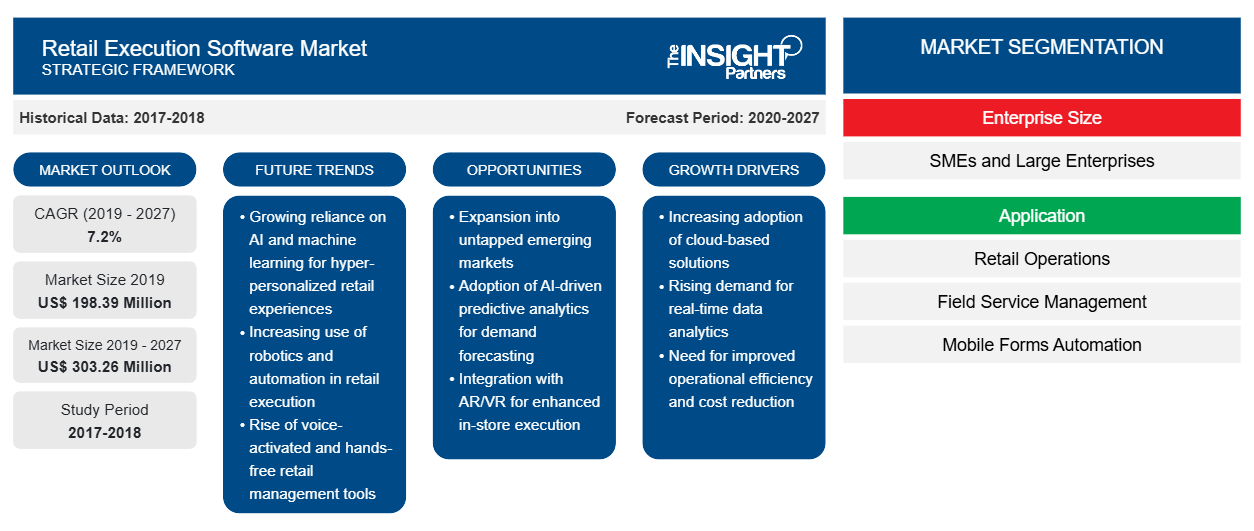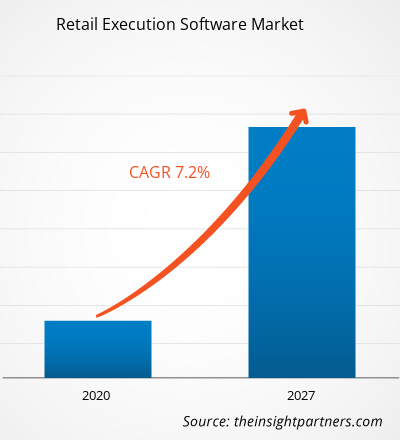The retail execution software market was valued at US$ 198.39 million in 2019 and it is projected to reach US$ 303.26 million by 2027; it is expected to grow at a CAGR of 7.2% from 2020 to 2027.
The global retail execution software market is witnessing substantial growth owing to the growing preference of retail and e-commerce platforms and increasing integration of payment gateways with retail execution software. Based on geography, North America led the market with 31.13% revenue share, followed by Europe and APAC. The presence of fast-growing economics, rising adoption of automated technology, increasing penetration of internet, and huge adoption of software by end users are among the prime factors expected to drive the growth of the retail execution software market in these regions. The retail execution software market in APAC is anticipated to grow at the highest CAGR during the forecast period. Rising adoption of advanced technologies in the retail industry drives the adoption rate of retail execution software. Companies invest in software to streamline their business operations. In APAC, the fastest-growing markets for retail and e-commerce are India and China. Consumers of these countries are highly inclined toward online shopping owing to rising internet penetration, and online shopping trends are transforming several areas of retail and e-commerce in the region. Thus, these factors are propelling the growth of the retail execution software market in APAC. Other developing regions, such as MEA and SAM, are also projected to grow at a steady pace owing to the increasing government initiatives to digitalize the economy with the adoption of advanced technologies.
Customize This Report To Suit Your Requirement
You will get customization on any report - free of charge - including parts of this report, or country-level analysis, Excel Data pack, as well as avail great offers and discounts for start-ups & universities
Retail Execution Software Market: Strategic Insights

-
Get Top Key Market Trends of this report.This FREE sample will include data analysis, ranging from market trends to estimates and forecasts.
Impact of COVID-19 Pandemic on Retail Execution Software Market
According to the latest report from World Health Organization (WHO), the US, Spain, Italy, France, Germany, the UK, Russia, Turkey, Brazil, Iran, and China are among the worst affected countries due to the COVID-19 outbreak. The crisis is adversely affecting the industries worldwide. The global economy took the worst hit in 2020, and it is likely to continue in 2021 also. The outbreak has created significant disruptions in primary industries such as logistics, retail, and e-commerce. The sharp decline in the international logistics business industry is restraining the growth of the global retail execution software market.
Retail Execution Software Market Insights
Increasing Integration of Payment Gateways with Retail Execution Software
Fuels Growth of Retail Execution Software Market
Online payments are relatively popular in APAC as most consumers use mobiles to pay for goods. Several popular e-payment options are used for mobile digital purchases in countries, such as South Korea, Japan, Singapore, and Australia. Payment gateway companies in these countries are offering comprehensive e-payment solutions to various retail execution software providers in order to catch the wave of technological development. Further, the market growth is attributed to advancements in payment gateway technology and increase in use of mobile wallets. Rising integration of payment gateway systems with retail execution software and rising online shopping, together with advancements in billing methods, are further expected to fuel the demand for retail execution software during the forecast period.
Enterprise Size-Based Market Insights
Based on enterprise size, the retail execution software market is bifurcated into large enterprises and SMEs. In 2019, the large enterprises segment accounted for a significant share in the market. However, the SMEs segment is anticipated to register a significant CAGR during the forecast period.
Application-Based Market Insights
Based on application, the retail execution software market is segmented into retail operations, field service management, mobile forms automation, field sales, trade promotion management, employee engagement, and others. In 2019, the retail operations segment accounted for a significant share in the market. Retail operations involve the management of individuals, supply chain, store layout, cash operations, physical inventory, and management of master data, promotions, and pricing. Retail execution software for retail operations equips brick-and-mortar retail stores with tools to take advantage of their current information and leverage it in a way that benefits their business.
Companies are highly engaged in developing new products to gain traction in the retail execution software market. For instance, Salesforce launched a new industry product, namely, Consumer Goods Cloud, which allows consumer goods companies to fuel revenue growth and increase ROI through enhanced retail execution capabilities. A few developments by key players are listed below:
2020:StayinFront, Inc. retail data insight (RDI) extended its partnership with Field Sales Solutions for real-time analytics. StayinFront RDI’s field view and ROI view, provide actionable insights to field sales teams. The services facilitate and maximize in-store effectiveness, allowing Field Sales Solutions’ clients the ability to do more, know more, and sell more.
2018:Intelligence Retail approached IBM to enhance its main offering and allow its customers to take advantage of tracking the key store audit indicators in actual-time. A new analytical module of the Intelligence Retail solution, based on the embedded IBM Watson Analytics technologies, is designed to help effectively track the key indicators of the retail audit by actual-time processing big data, including the availability of goods on the shelf, shelf share, prices, and promotions
The regional trends and factors influencing the Retail Execution Software Market throughout the forecast period have been thoroughly explained by the analysts at The Insight Partners. This section also discusses Retail Execution Software Market segments and geography across North America, Europe, Asia Pacific, Middle East and Africa, and South and Central America.
Retail Execution Software Market Report Scope
| Report Attribute | Details |
|---|---|
| Market size in 2019 | US$ 198.39 Million |
| Market Size by 2027 | US$ 303.26 Million |
| Global CAGR (2019 - 2027) | 7.2% |
| Historical Data | 2017-2018 |
| Forecast period | 2020-2027 |
| Segments Covered |
By Enterprise Size
|
| Regions and Countries Covered |
North America
|
| Market leaders and key company profiles |
|
Retail Execution Software Market Players Density: Understanding Its Impact on Business Dynamics
The Retail Execution Software Market is growing rapidly, driven by increasing end-user demand due to factors such as evolving consumer preferences, technological advancements, and greater awareness of the product's benefits. As demand rises, businesses are expanding their offerings, innovating to meet consumer needs, and capitalizing on emerging trends, which further fuels market growth.

- Get the Retail Execution Software Market top key players overview
By Enterprise Size
- Large Enterprises
- SMEs
By Application
- Retail Operations
- Field Service Management
- Mobile Forms Automation
- Field Sales
- Trade Promotion Management
- Employee Engagement
- Others
By Geography
-
North America
- US
- Canada
- Mexico
-
Europe
- France
- Germany
- Italy
- UK
- Russia
- Rest of Europe
-
Asia Pacific (APAC)
- China
- India
- South Korea
- Japan
- Australia
- Rest of APAC
-
Middle East & Africa (MEA)
- South Africa
- Saudi Arabia
- UAE
- Rest of MEA
-
South America (SAM)
- Brazil
- Argentina
- Rest of SAM
Company Profiles
- Bizom (Mobisy Technologies Private Limited)
- EdgeCG (StayinFront, Inc.)
- Intelligence Retail
- Mobisoft
- POPProbe
- Spring Mobile Solutions, Inc.
- Trax Technology Solutions Pte Ltd.
- Valomnia
- WINIT
- Kantar Group
Frequently Asked Questions
Which industry led the Retail Execution Software market?
Which region held the largest share in 2019 of the Retail Execution Software market?
Which factor is driving growth of the Retail Execution Software market?
- Historical Analysis (2 Years), Base Year, Forecast (7 Years) with CAGR
- PEST and SWOT Analysis
- Market Size Value / Volume - Global, Regional, Country
- Industry and Competitive Landscape
- Excel Dataset
Recent Reports
Related Reports
Testimonials
Reason to Buy
- Informed Decision-Making
- Understanding Market Dynamics
- Competitive Analysis
- Identifying Emerging Markets
- Customer Insights
- Market Forecasts
- Risk Mitigation
- Boosting Operational Efficiency
- Strategic Planning
- Investment Justification
- Tracking Industry Innovations
- Aligning with Regulatory Trends





















 Get Free Sample For
Get Free Sample For